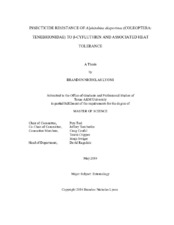| dc.description.abstract | The lesser mealworm Alphitobius diaperinus (Panzer) (Coleoptera:
Tenebrionidae) is an important economic pest to poultry producers globally that cause
structural damage and spread pathogens to poultry. Adult lesser mealworms were
collected from three farms in Mt. Pleasant, TX, USA (A-C) and three farms in Franklin,
TX, USA (D-F) in order to assess insecticide resistance across populations, as well its
relationship to heat tolerance. Filter papers were treated with a range of doses of the active
ingredient (AI) β-Cyfluthrin. Farms B and E displayed much higher LD_(50) of 0.320 mg/mL
and 0.627 mg/mL respectively compared to the remaining four farms, which ranged from
0.048-0.161mg/mL. In addition, a field bioassay was conducted to determine adult beetle
susceptibility to label rates of formulated permethrin, Vector Ban Plus™ and a pyrethroid,
Tempo SC Ultra™. These insecticides were applied to commonly found surfaces in
poultry operations (concrete, wood chip particle board, and pressure treated wood). Adult
beetles were exposed to the treated surfaces for 2 h and then placed in untreated sterile
petri dishes. “Mortality” refers to mortality and morbidity recorded together at 2, 24, and
48 h post-exposure for both bioassays. Insecticide resistance varied greatly based on
observation period and compound. The range of mean mortalities measured at 2 h
regardless of surface type for Tempo SC Ultra™ was 58-100% and for Vector Ban Plus™
17-100%. The mean mortality range at 24 h regardless of surface for Tempo SC Ultra™
(91-100%) had less than 10% variation, while Vector Ban Plus™ (0.00-49.73%)
displayed almost 50% variation. The mean mortality range at 48 h regardless of surface
for Tempo SC Ultra™ (72-100%) showed high knockdown and increased in variation by 30%, and Vector Ban Plus™ (0-29%) had a similar variation, but with low knockdown. Mortality was similar for Tempo SC Ultra™ for each substrate. β-Cyfluthrin (AI) had varying effectiveness depending on the population’s resistance levels, however all the farms tested had LD_(50) well above the equivalent formulation dosage of 0.02mg/mL. The β-Cyfluthrin formulation had high mortality on all the surfaces tested highlighting the importance of the other ingredients in a formulation. Heat tolerance experiments were conducted on the F_(1) progeny of populations B, D, and E (n=14). The heat shock results were inconclusive. Modification to the experimental design may be needed to yield comparable results. | en |


